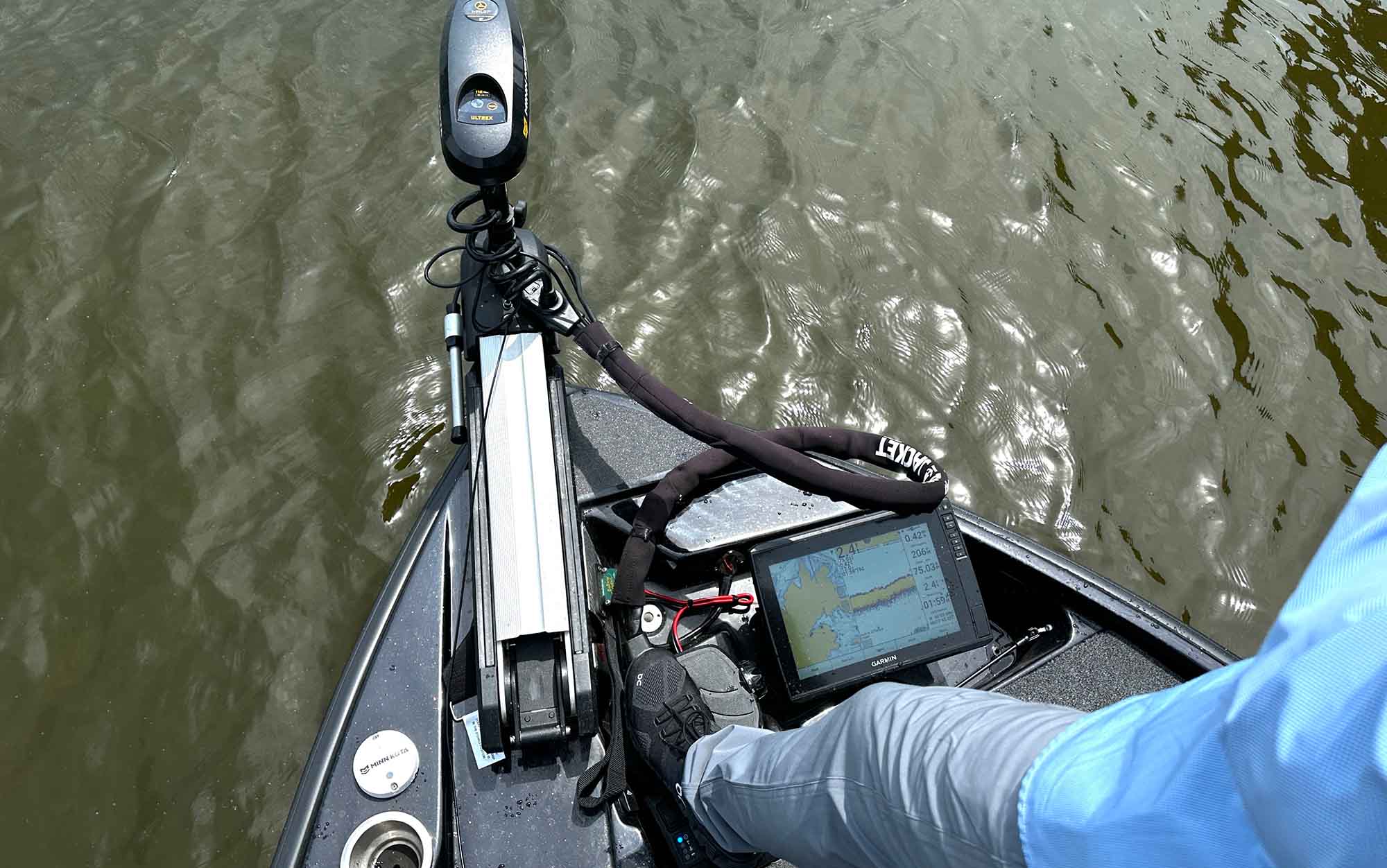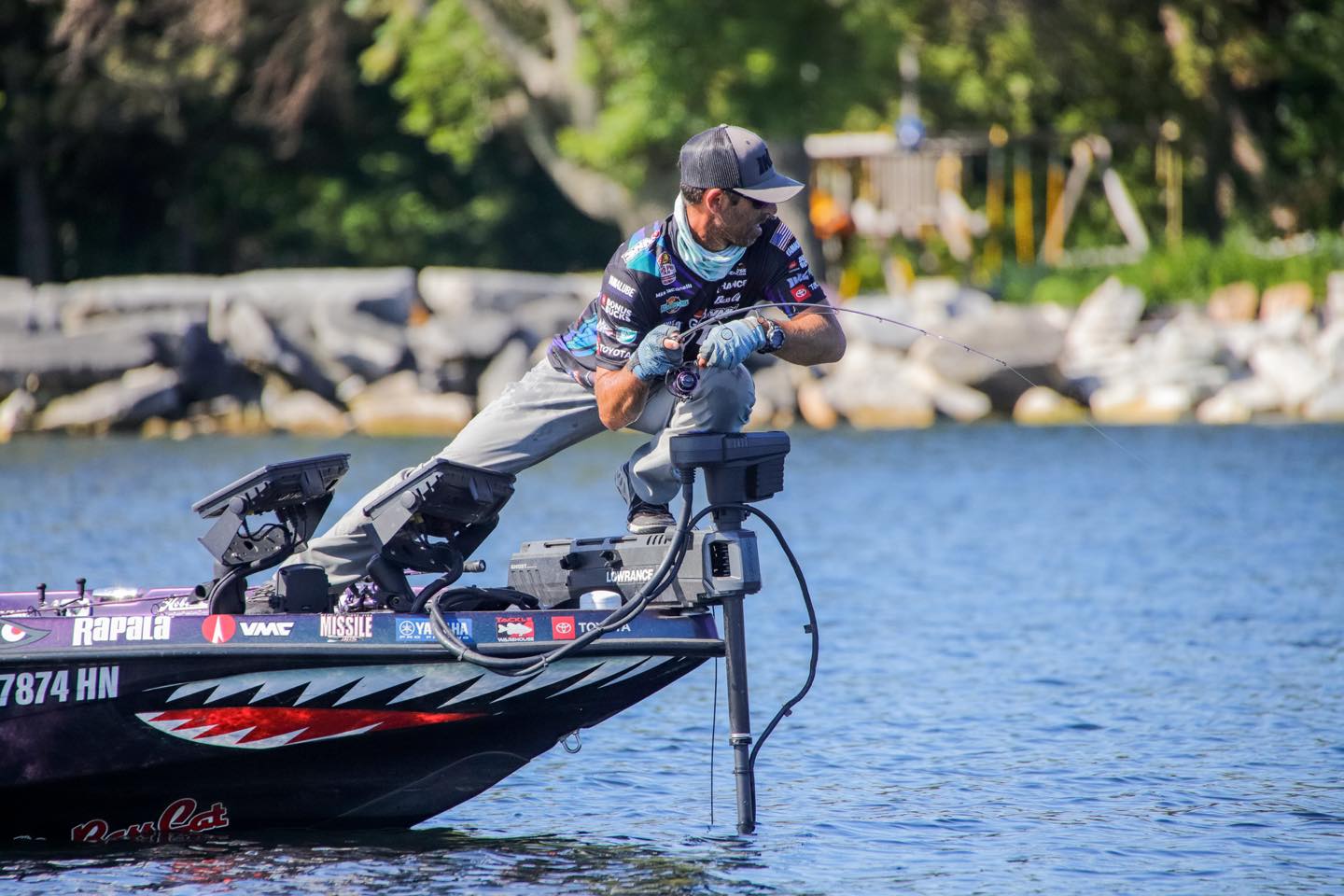We may earn revenue from the products available on this page and participate in affiliate programs. Learn More ›
The best spot lock trolling motors seem to turn the idea of “best” on its ear. After all, manufacturers competed for years to see which trolling motor would keep going, whether through waves, through submerged aquatic vegetation, or at the end of a long day when battery power is wearing down. Now we’re asking those same tools to sit put, and to do it precisely, until we ask it to move.
Spot-Lock revolutionized the game for offshore anglers who want to make the same cast repeatedly, particularly when there are no landmarks or visual cues to inform your positioning. That’s not the only situation where they can excel, however. Spot-Lock trolling motors can be used to hold a boat against a raging current or to prevent you from blowing into rocks or other obstacles as you land a fish or retie your line. To truly be the best, however, they need to do this flawlessly and still deliver on the promises of yesteryear—maximum power, maximum durability, and relative silence. Here are four of the best spot-lock trolling motors.
How I Tested the Best Spot-Lock Trolling Motors
I’ve run all four of these brands on everything from shallow, grassy tidal rivers to the ledges of the big TVA impoundments to the Great Lakes, and I’ve realized that much of what makes a trolling motor good is a matter of personal preference. Do you like a loose pedal or one with more tension? Do you value relative silence over power? How important is the brand of sonar that you use?
I know that while I use Spot-Lock frequently, my Power Poles also usurp some of their role. I rarely use the autopilot or the remote, but I demand the clearest picture possible. I’m also rough on equipment—as they get more feature-packed, that’s just more things that could break or fall victim to the elements. I want my trolling motor to hold in place every time I tell it, but the most important thing is that it runs efficiently every time I step on the button.
Best Spot-Lock Trolling Motors: Reviews & Recommendations
Best in Heavy Grass: Minn Kota Ultrex
See It
Key Features
- Shaft Lengths: 45, 52, 60 inches
- Built-in Sonar: MEGA Down Imaging, Universal Sonar 2, MEGA Down/Side Imaging
- Voltage/Thrust: 36v/112 pounds or 24v/80 pounds
Pros
- Great in aquatic vegetation
- Lift assist makes it easy to deploy and retrieve
- Very responsive foot pedal
Cons
- Sometimes tough to source due to supply chain issues
The first entrant in the Spot-Lock game—indeed, the company that coined the phrase—continues to lead the charge in its integration with Humminbird Electronics. Minn Kota changed the trolling motor landscape when they introduced the Ultrex, for the first time harnessing the power of GPS into precise positioning mechanisms for anglers everywhere. No longer was it necessary to guess the location of a ledge, brush pile, or rock pile. Instead, anglers could command the troller to take them there and keep them there for cast after productive cast.
They’ve improved their game substantially since then, in lockstep with improvements to their paired Humminbird electronics. Now you can buy an Ultrex with a built-in MEGA Imaging transducer to get crystal clear pictures.
You can also pair it to your Apple or Android device and operate it remotely or from another part of the boat. What I like most about mine is that I’ve plowed it through acres of grass thick enough to plow, and it comes out the other side clean and almost immediately ready to engage in its spot-holding job. While technology is great, if it doesn’t work in the rigors that anglers typically expose it to, the advances aren’t worth much. Minn Kota has this one down pat, even if you decide to use a different brand of electronics.
Read Next: The Best Trolling Motors
See It
Key Features
- Shaft Lengths: 47, 52, 60 inches
- Built-in Sonar: Hdi Sonar Nosecone
- Voltage/Thrust: 36v/120 pounds or 24v/97 pounds
Pros
- Interference-free sonar picture
- Configurable foot pedal
- Quiet, brushless motor
Cons
This super-quiet brushless motor has a customizable foot pedal and convenient features. When Lowrance entered the spot lock game, they built upon their pioneering role in the sonar world to provide an angler-friendly yet technologically-advanced product. It was immediately embraced as one of the best spot-lock trolling motors, due to its brushless design.
This brushless motor is super-quiet and provides the most pounds of thrust per volt in its category. What I like about the Ghost is that the foot pedal is customizable. Years ago, when I first switched from MotorGuide—which had the button on the right side of the pedal—to Minn Kota—which had it on the left—several times a day, I’d mash down on the pedal and get no response for reasons that were almost instantly obvious. This simple feature allows anglers to put the button where they like it. It also includes a battery level indicator and programmable easy-access keys that allow the user to quickly drop a waypoint rather than bending over and engaging the paired sonar unit by hand. That’s a time-saver and a huge means of adding efficiency.
Most Indestructible: Power Pole Move
See It
Key Features
- Shaft Lengths: 45, 52, and 60 inches
- C-Monster 2.0 wireless communication
- Lifetime warranty on shaft (3 year on other components)
- 20 speed settings
- Thrust: 100lbs with 36V/78lbs with 24V
- Shaft Material: Aerospace Grade Titanium
- Scissor mount
- Weight: 53 to 55 pounds depending on shaft length
- Anchor mode and follow route mode
- Made for fresh and saltwater
Pros
- Durable shaft material
- Can run on 36 or 24 volts
- Wireless control
Cons
- Still untested on a large scale
Rumors of an imminent Power Pole trolling motor started circulating several years ago. Still, the company delayed the public release until early 2023 because they wanted to stress test the heck out of it. They put it through every possible rigor and obstacle before releasing it to the public. That’s typical of the company, which built its name through innovative shallow water anchoring systems, but cemented its legacy through customer service and by over-engineering its products. This new trolling motor lives up to that latter legacy insofar as you can crash through waves, bang into stumps, run it all day at high speed, and still keep ticking.

There are two different models, the ZR and the PV, with a scissor lift and pivot mount, respectively, but that’s a major difference. They’re both made to be corrosion-resistant in fresh and saltwater and with various backup systems to guard against losing your ability to use the motor when you need it most. That starts with a titanium shaft (45, 52, or 60 inches) with an unconditional lifetime warranty and extends to the ultra-quiet brushless motor. Even the propeller is custom-made to be more efficient and weedless, and you can run the motor on 24 or 36 volts of battery power.
The Move has new tech like a wireless pedal, wireless remote control, and wireless foot switches. Still, the real advantage is the ability to pair them with the best fish finders, particularly with Lowrance and Simrad units. The ZR even has an optional built-in transducer for Lowrance units. The motor has anchor mode, a vector mode, and a compass heading, but the most impressive is the “Follow a Route,” which allows anglers to set a complex and winding route ahead of time, and the motor will trace it flawlessly.
See It
Key Features
- Shaft Lengths: 50 and 57 inches
- Built-in Sonar: Transducer for CHIRP traditional and Ultra High-Definition ClearVü and SideVü scanning sonars.
- Voltage/Thrust: 36v/100 pounds or 24v/80 pounds
Pros
- Extremely quiet
- Water-resistant, floating remote control
- Dual gas springs make retraction and deployment quiet and easy on your back
Cons
- Most expensive of the motors surveyed
Despite winning the ICAST New Product Showcase Best of Show award three years ago, Garmin continues to innovate. They were the first company to widely popularize and innovate in the forward-facing sonar space—making one of the best fish finders— which gave them a leg up when it came to integrating their Force trolling motors with their paired electronics. Refined transducers provide a clearer or more interference-free picture than ever, but this trolling motor is a beast even without the benefit of their leading GPS technology. The foot deal is wireless and incredibly responsive, requiring AA batteries, although it can be hard-wired. You can point the floating, waterproof remote in the direction you want to go, and the Force will take you there. If tech is your thing, and you value it in your fishing, consider this advanced model.
Best for Forward Facing Sonar: Minn Kota Ultrex Quest
See It
Key Features
- Shaft Lengths: 45, 52, and 60 inches
- Built-in Sonar: MEGA Down/Side Imaging, Dual Spectrum Chirp
- Voltage/Thrust: 36v/112 pounds, 24v/80 pounds, or 24/36v with 90 or 115 pounds
Pros
- Connects easily with Humminbird electronics
- Highly-responsive pedal design
- One boat network controls all compatible accessories
Cons
- May be overkill on price and features for some anglers

Scott Einsmann
MinnKota took its pathfinding product, the one that set the course for all Spot Lock motors, and made it quieter, more responsive, and more feature-rich. You’ll especially want this upgrade if you’re an ardent user of forward facing sonar, because it has the most precise pedal on the market. It’s able to make minute and exact changes in direction and then hold them in place easily, for a clearer picture of what’s in front of you. I found the original Ultrex to be great in grass, but this one has even more torque, and seems to conserve battery power under the harshest use. It’ll go, go, go, but when it’s time to stop in place, the original spot locker will keep you exactly where you want to be.
Best for Multiple Sonar Brands: MotorGuide Tour Pro
See It
Key Features
- Shaft Lengths: 45 inches
- Built-in Sonar: Pinpoint GPS and optional HD+ Universal Sonar
- Voltage/Thrust: 36v/109 lbs. or 24v/82 lbs.
Pros
- Works equally well with all major sonar brands
- Effortless true cable steering
- 360 degree breakaway mount
Cons
- Not built for one particular brand of sonar
Unlike the three trolling motor manufacturers above, MotorGuide is not partnered directly with an electronics manufacturer. Rather than seeing that as a negative, however, they view it as a positive, meaning that you can mix and match your systems (even using two or more different brands of sonar) without losing effectiveness or precision. They didn’t need to reinvent the wheel with years of heritage in the trolling motor game compared to some of their competitors. Instead, they matched durability with flexibility.
The shaft consists of an oversized metal outer column paired with an unbreakable inner composite piece. I know anglers who are beyond rough on their gear, who grind them into riprap and massive stumps, and still, the MotorGuide keeps on ticking. The metal foot pedal is also bulletproof, which means it’s always where you expect it to be and won’t get beat to death by either massive waves or hard-stomping tournament partners.
Best for Saltwater: Minn Kota Riptide Terrova
See It
Key Features
- Bluetooth connectivity
- Pre-installed i-Pilot integrated GPS
- Industry-leading combination of proven yet modern design
- Wireless remote with fully redesigned layout, 33% larger LCD screen, expandable menus, and intuitive navigation
- Remote also controls motor, Spot-Lock, iTrack Record/Playback, Backtrack, Cruise Control, and more
- Unprecedented remote-control operation
- One-Step Stow with Deploy Lever
- Push-to-test battery meter
Pros
- Easy deployment
- Can anchor in place or control a drift
Cons
The key to the system is the i-Pilot remote with large buttons and an easy-to-read screen monitoring the motor’s functions. Not only can I control the direction and program the motor, but the Terrova offers a one-step deploy lever. Just hit the lever, and the motor deploys, hit it again, and it stows.
It also features i-Pilot, which allows me to control the direction, program speed, and route and virtually anchor the boat. The i-Pilot is perfect for programming a course for trolling or to repeat a drift. The most popular function, Spot-Lock, allows me to stop the boat and hold position over a piece of structure or in the perfect position for casting a lure or fishing a bait.
Best for Big Water: Garmin Kraken
See It
Key Features
- Shaft Lengths: 64, 75, and 90 inches
- Built-in Sonar: Wireless integration with Garmin chartplotters
- Voltage/Thrust: 24/36v, 100 pounds
Pros
- Stays in the water when it gets rough
- Brushless motor is extremely efficient
- Includes GT56 transducer
Cons
- Live sonar technology costs extra
Just as MinnKota pioneered Spot Lock technology, Garmin was the driving force in making forward facing sonar a must-have accessory for serious anglers. I’ve been running their graphs for several years now and I find them to be the clearest, most reliable, and least buggy options, so pairing them with a trolling motor that’s fully compatible and integrated only makes sense.
The shaft lengths may be overkill for the average bass angler or aluminum boat guy, but if you need to stay on walleye or smallmouths on the Great Lakes, this is the tool you want. It’s even saltwater rated, so you can take it out in truly big water. By connecting it to your graphs, you can stay in place in just about any conditions, as well as create routes and tracks easily. The LiveScope cable runs through the trolling motor shaft so it won’t get nicked or pinched, meaning you’ll always be able to stay where you are or get back to a given spot, as needed.
Things to Consider Before Buying the Best Spot-Lock Trolling Motors

Necessity
Spot lock technology can be an absolute game-changer for anglers who need to remain in one place indefinitely, but each new feature that you add increases price and complexity. All four of the best trolling motor manufacturers have upped the reliability of their products, but at this stage in the game, most of us should admit that if something goes wrong, we’ll be unable to fix it ourselves.
Battery Power
Do you need a 36-volt system, or can you get away with 24 volts? Does your boat have room for three batteries? Can you justify the expense of lithium batteries? Modern electronics drain batteries quicker than ever before, which may not be an issue if you have one of the best trolling motor batteries, but they don’t come inexpensively.
Preferred Sonar Brand
Usually, but not always, trolling motors that come from the factory ready to be paired with a partner brand of electronics work best with those electronics. If you’re going to use multiple graphs, that might not be a factor, but a consistent corporate nameplate may in some cases, ease setup and troubleshooting practices.
Rumors of Other Brands
While the four brands listed above are the leaders in this space, there have long been rumors that there will be other entrants to the market. Should you wait if you prefer one of those?
FAQs
The added technology necessary to build motors with spot lock capability has raised most units’ prices well above $2,000, and some are priced closer to $4,000. This depends on the number of features incorporated, along with the length of the shaft and incorporated power. Of course, electronics and batteries are not included in this pricing.
It is fairly easy to remove a trolling motor from an unattended boat, but it is likely not feasible to store it for safekeeping each time you store it. Accordingly, if you are worried about your expensive trolling motor being stolen, it might pay to invest in a lock like those from DuraSafe. They’re not 100% foolproof, but they may act as a deterrent.
The MotorGuide Tour models seem to be at the low end of the spot lock trolling motor price spectrum, although they are by no means u0022cheap.u0022 Several of the others are well over $3,000, in some cases approaching $4,000.
Final Thoughts
As our fisheries get more highly pressured, and our fish become more educated, precision boat positioning is increasingly important. Being able to make that “money cast” over and over and over again requires the best use of your trolling motor and your GPS, and in most cases that requires one of the best spot-lock trolling motors. Are they strictly necessary? Not always, but the technology makes life a lot easier and a lot fishier. Depending on your electronics needs, a particular brand may be better than the others for you, but all four major players produce a quality product.
Read the full article here




